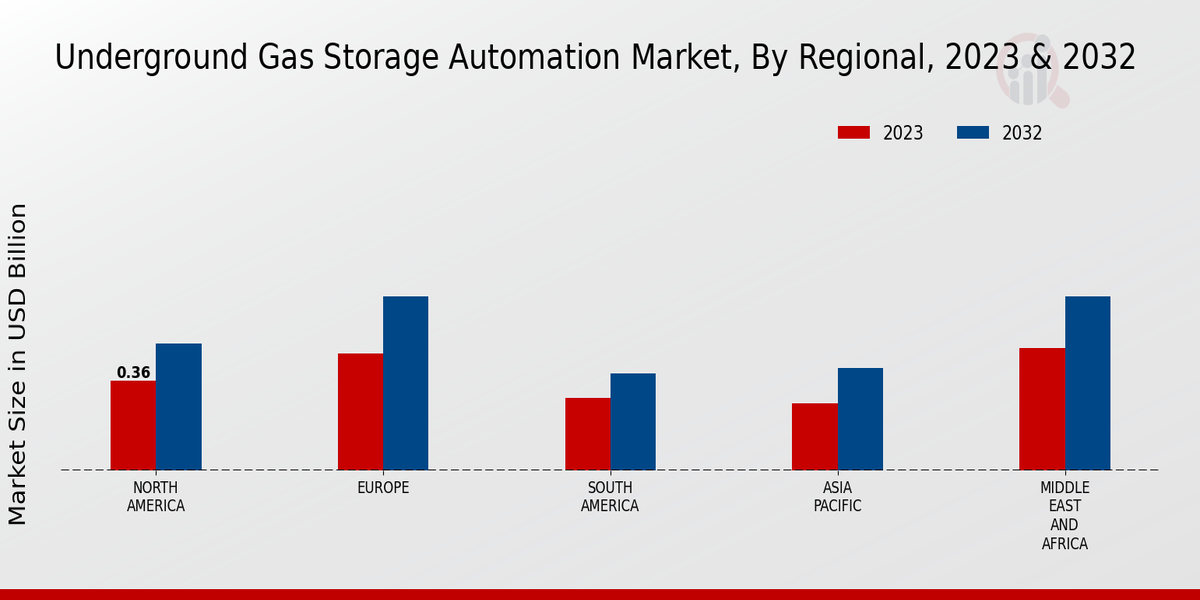Increasing Demand for Natural Gas
The Global Underground Gas Storage Automation Market Industry is experiencing a notable surge due to the rising demand for natural gas as a cleaner energy source. As countries aim to reduce carbon emissions, natural gas is increasingly viewed as a transitional fuel. In 2024, the market is projected to reach 2.04 USD Billion, reflecting the growing reliance on natural gas for electricity generation and heating. This trend is further supported by government policies promoting natural gas usage, which enhances the need for efficient storage solutions. Consequently, automation technologies are being integrated to optimize storage operations, ensuring reliability and efficiency in gas supply.
Regulatory Support and Policy Frameworks
The Global Underground Gas Storage Automation Market Industry benefits from supportive regulatory frameworks that encourage the adoption of automation technologies. Governments worldwide are implementing policies aimed at enhancing energy security and promoting the efficient use of natural gas. These regulations often include incentives for the adoption of advanced technologies in gas storage facilities. As a result, operators are increasingly investing in automation solutions to comply with these regulations and improve their operational efficiency. This trend is anticipated to contribute to the market's growth, with projections indicating a market value of 3.19 USD Billion by 2035, driven by regulatory support.
Technological Advancements in Automation
Technological innovations play a crucial role in shaping the Global Underground Gas Storage Automation Market Industry. The advent of advanced automation technologies, such as IoT and AI, facilitates real-time monitoring and predictive maintenance of gas storage facilities. These technologies enhance operational efficiency and safety, reducing the risk of accidents and downtime. As automation systems become more sophisticated, they enable operators to manage gas storage more effectively, leading to cost savings and improved performance. The integration of these technologies is expected to drive market growth, as stakeholders seek to leverage automation to optimize their operations and meet regulatory requirements.
Rising Investments in Energy Infrastructure
The Global Underground Gas Storage Automation Market Industry is bolstered by increasing investments in energy infrastructure, particularly in developing regions. As countries expand their energy networks to accommodate growing populations and industrial demands, the need for efficient gas storage solutions becomes paramount. Investments in automation technologies are essential for enhancing the reliability and efficiency of gas storage operations. This trend is evident as stakeholders recognize the importance of modernizing their infrastructure to meet future energy demands. The anticipated compound annual growth rate of 4.14% from 2025 to 2035 underscores the potential for growth in this sector, driven by infrastructure investments.
Market Consolidation and Strategic Partnerships
The Global Underground Gas Storage Automation Market Industry is witnessing a trend towards consolidation and strategic partnerships among key players. Companies are increasingly collaborating to leverage each other's strengths, share resources, and enhance their technological capabilities. These partnerships often focus on developing innovative automation solutions that address the evolving needs of the gas storage sector. By consolidating their efforts, companies can achieve economies of scale and accelerate the deployment of advanced technologies. This trend is likely to shape the competitive landscape of the market, fostering innovation and driving growth in the coming years.



 Source: Primary Research, Secondary Research, MRFR Database and Analyst Review
Source: Primary Research, Secondary Research, MRFR Database and Analyst Review



















Leave a Comment